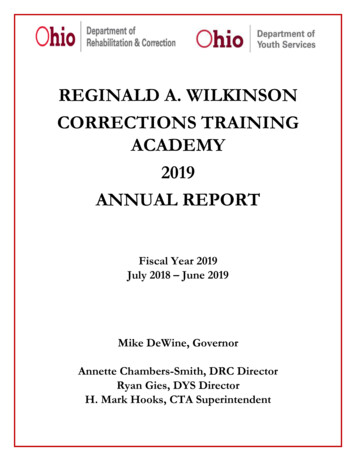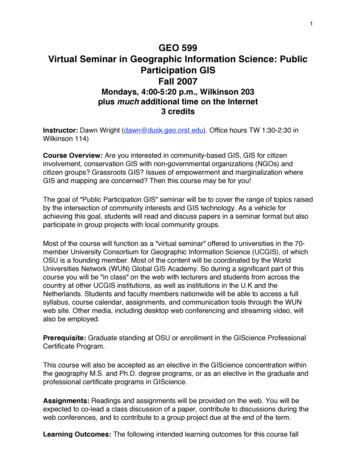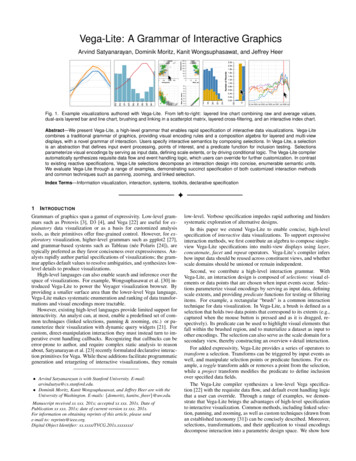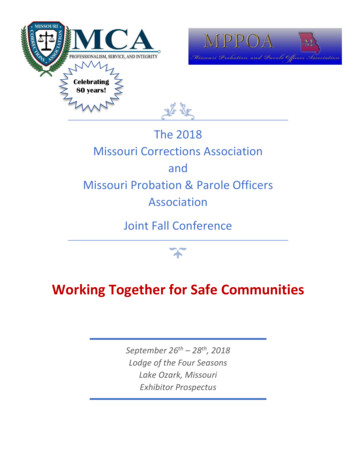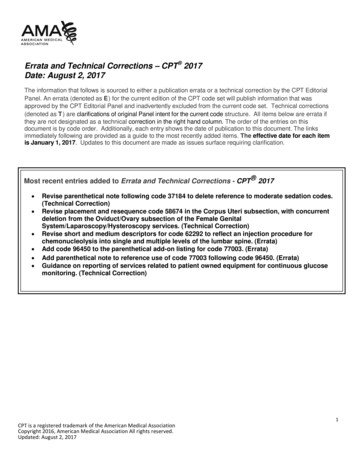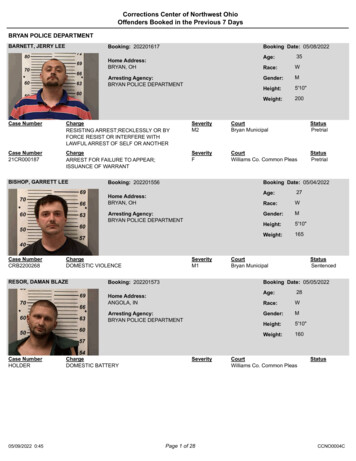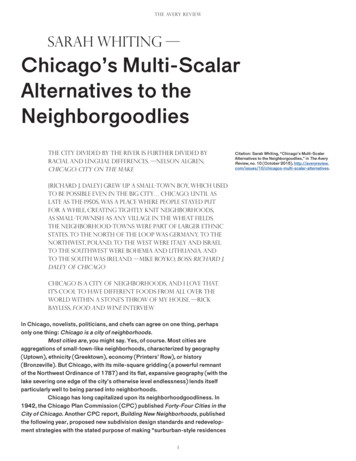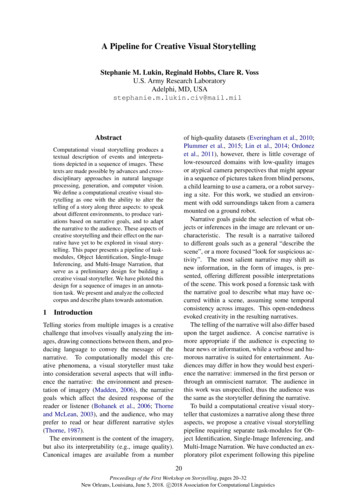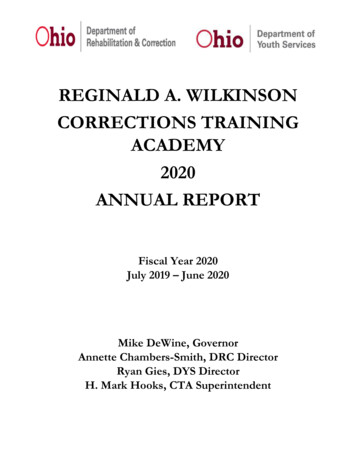
Transcription
REGINALD A. WILKINSONCORRECTIONS TRAININGACADEMY2020ANNUAL REPORTFiscal Year 2020July 2019 – June 2020Mike DeWine, GovernorAnnette Chambers-Smith, DRC DirectorRyan Gies, DYS DirectorH. Mark Hooks, CTA Superintendent
Table of Contents3Overview4Administration9Personnel Updates10Policy Administration12Operations18Business Office19DRC Training Requirements21DYS Training Requirements22DRC Curriculum Development24DYS Curriculum Development25DRC Field Support28DYS Field Support30DRC New Employee Orientation32DYS Pre-Service34DYS Continuing Education Units2
OverviewThe Reginald A. Wilkinson Corrections Training Academy (CTA) provides quality training andcustomer service to employees of the Department of Rehabilitation and Correction (DRC), theDepartment of Youth Services (DYS), and agency partners. CTA’s dedicated staff is responsible forthe development, coordination, and implementation of training sessions that provide students withindividual and professional development opportunities through DRC’s New Employee Orientation(NEO), DYS’ Pre-service program, and the required and specialized in-service trainings for bothagencies. CTA also hosts a wide variety of trainings and special events.The curricula for NEO, Pre-service, and in-service programs are developed based on the needs ofstaff in the field as identified through training assessments, agency updates, and suggestions fromstaff and leadership of the agencies. Annually, CTA offers numerous e-learning courses andcontinues to expand its program offerings based on the identified needs of our stakeholders.Curricula is developed and enhanced through collaboration with DRC and DYS’s statewideTraining Advisory Councils (TAC), employee surveys, the National Institute of Corrections (NIC),and other correctional and outside criminal justice professionals.Both, DRC’s NEO and DYS’s Pre-service programs are required for all staff beginning theircareers with both agencies and the private institutions that DRC is partnered with. The objective ofthese programs is to prepare staff to be confident and competent in their jobs and to provide theagency with employees who are better prepared to serve in a correctional environment.CTA offers a variety of specialized in-service training programs designed to complement annual inservice training while meeting the professional development needs of each employee. Specializedin-service programs are managed by CTA staff who consult with subject matter experts andinstructor trainers to develop, update, and improve these programs. A catalog of CTA in-servicecourse offerings is provided and accessible within the learning management system, Ohio Learn.3
AdministrationCOVID-19 Pandemic OperationsIn March 2020, DRC and DYS initiated pandemic procedures due to the COVID-19 Pandemic. On March 11, 2020, all in-service students at CTA were dismissed to their work sites.Unfinished courses are set to be rescheduled when pandemic restrictions are lifted. NEO and Pre-service trainings were adjusted to meet pandemic restrictions, includinglimiting the number of students in a classroom and altering the facilitation of all courses.This required the creativity and participation of all CTA staff. Governor DeWine asked that all staff who were able to complete their job duties remotely.For CTA this included most staff with the exception of the Operations unit. From April of 2020 through the remainder of the fiscal year, CTA was closed for regularbusiness and most courses were moved to a virtual platform. Both DRC and DYS received waivers from the American Correctional Association (ACA)for standards related to training. Several variances were enacted pertaining to training policies due to pandemic and socialdistancing protocols, most notably the transition of NEO to a virtual platform and changesto physical skills requirements for the duration of the pandemic. FY20 instructor led in-service courses on the requirement letters for both agencies wereconverted to eLearning’s so all staff could complete required trainings. As a result of the unprecedented pandemic, the staff at CTA worked together to shift newhire training (i.e., NEO, Pre-service) from the traditional in-person format to a virtualinstructor led format with the assistance of staff in the field. Facilitation methods, coursematerials, and the methods of distributing and collecting equipment and records had to bereworked. The turnaround time for creating and implementing the virtual new hire trainingswas very short and the team at CTA did a wonderful job accomplishing this. The staff in theDRC NEO and DYS Pre-service units, with assistance from varying other CTA staff, tookon the new challenges and excelled.Activities and Accomplishments In FY20, Superintendent Mark Hooks continued creating opportunities for DRC and DYSstaff to develop their leadership skills by bringing the John Maxwell company backthroughout the fiscal year. Multiple offerings of the 5 Level of Leadership course wasoffered to first time John Maxwell students and shorter workshops were offered to 5 Levelgraduates who wished to continue building their leadership skills.o John Maxwell 5 Levels of Leadership 10/17/19 – 5 Levels of Leadership (31 attended) 1/30/2020 – 5 Levels of Leadership (29 attended)o John Maxwell workshops 10/16/19 – Staff Engagement Workshop (11 attended)– Building Leadership Workshop (13 attended)4
10/18/19 – Live 2 Lead conference rebroadcast (14 attended) Appearance by Annette Chambers-Smith and Ernie Moore 1/31/2020 – Living the Laws of Leadership Workshop – Modules 1 & 2 (11attended)In November 2019, 25 employees from DRC and DYS successfully completed theExecutive Leadership program.CTA hosted the Managing Officers Meeting in December 2019.CTA’s Internal Management Audit (IMA) was set to be held June 2-3, 2020 but wasrescheduled to a virtual audit in November 2020.In FY20, three CTA staff were recipients of the DRC Gold Star award.o Jason Rankin, Scott Tharp, and Jim Eberlin were awarded the DRC Gold Star fortheir intervention with a residential student experiencing a mental health crisis.ACA Coordination CTA’s Year 2 IMA was conducted July 30-31, 2019. Due to restructuring of the ACAschedule, this audit cycle was only two years as opposed to the traditional three, and 2020will be a Year 1 IMA.o CTA received an overall audit score of 100% 100% on ACA Non-Mandatory Standards. 100% on ACA Mandatory Standards. 100% on Ohio Standards Mandatory CTA’s ACA audit took place September 18-19, 2019.o This was the first audit combining DRC and DYS accreditations into one for CTA asopposed to one accreditation for each agency’s branch of the academy. CTA received an overall audit score of 100%.5
ACA Audit6
2019 Executive Leadership7
John Maxwell Workshops“I particularly like the way the workshop clarified the positional leader from the leaderthat has gained influence and permission to lead. (Do you care for me? Do I trust you?)All too often within our agency we rely on positional leadership to meet the demands ofour operations. Positional leadership worked for years when the job market wasn’t what itis today. Our staff expect more now. And we owe that to them as leaders to invest inbecoming better for ourselves, those we lead and the department as a whole.”– Captain Mike Antle, PCI5 Levels of Leadership8
Personnel UpdatesMary Davis joined the CTA team in 2019 and wasassigned as the CTA Assistant Superintendent andCurriculum Unit Supervisor. She has 25 years of peaceofficer experience with the last nine years serving in theAttorney General’s Office.Tom Stover joined CTA as a DRC TrainingOfficer in September 2019 . Tom previouslyserved DRC as a Corrections Officer andLieutenant at CRC for 13 years.In FY20, Richard Duncan joined CTA asan Academy Training Developer (ATD)for DYS. Prior to joining the CTA staff, hewas a Training Officer at CirclevilleJuvenile Correctional Facility.Montoyia Weir joined CTA as a ProgramAdministrator 2 on the DYS side of the house.Prior to coming to CTA, Montoyia served as aCase Manager at Indian River Juvenile CorrectionalFacility.In October 2019, the table of organization at CTA was changed to distribute resources more evenlyamong the units. The Curriculum Development and Field Support units each gained a third ATD. The Operations unit gained an ATD position. The NEO unit gained one ATA, one training officer, and went from seven to four ATDs.9
Policy AdministrationDRC All CTA owned policies (12-CTA, 38-CTA-06, 39-TRN) policies were reviewed, revised, andsubmitted for the director’s signature on or before July 1, 2020. Four 12-CTA policies were reduced to the local level: CTA communication, facility access,mission and goal development, and quarterly management inspections. Variances were implemented for several DRC policies, including three TRN policies, due tothe COVID-19 pandemic.o 39-TRN-02, In-Service Training “DRC policy 39-TRN-02, In-Service Training, requires that APA firearms recertification be competed annually, specifically, not to exceed 12 months. (39TRN-02 VLE.4) As a result of the COVID 19 pandemic, firearms recertification deadlines set forth in this policy will be extended until the end ofthe calendar year 2020.” “As a result of COVID 19 pandemic and social distancing protocols, FieldTactics and Arrest, Search and Seizure training requirements have beenpostponed. The postponement of Field Tactics and Arrest, Search and Seizuremay result in employees having less than the required hours as provided ontheir approved for FY20 training plans.” “As a result of the COVID 19 pandemic, PR-24 recertification deadlines setforth in this policy have been postponed.” “As a result of the COVID 19 pandemic, Cell Extraction recertificationdeadlines set forth in this policy have been postponed.” “As a result of the COVID 19 pandemic, DTSC re-certification deadlines setforth in this policy have been postponed. The postponement ofDTSC/Personal Safety recertification may result in employees having less thanrequired number of training hours for the FY20 training cycle.”o 39-TRN-10, Employee Orientation Training “DRC policy 39-TRN-10, Employee Orientation Training, (D.5) It isrecommended the facility maintain a ratio of three new corrections officersworking with one coach (3-to-1 ratio), but not to exceed a ratio of five newcorrection officers working with one coach (5-to-1 ratio) to ensure appropriateinstruction and assistance is provided the new employee. As a result of the COVID 19 pandemic, the facility may exceed the ratio of 5 to1 if operational need requires. It is the responsibility of the facility to ensureappropriate instruction and assistance is provided the new employee.” “During the duration of the COVID-19 event, All DRC sites have beenapproved to conduct their employees’ initial certification for defensive tacticssubject control.10
The approval begins with the Corrections Training Academy class NEO 20019 until this variance is rescinded.”o 39-TRN-15, APA Firearms Training “DRC policy 39-TRN-15, APA Firearms Training, requires that firearms recertification be completed annually, specifically, not to exceed 12 months. (39TRN-15 definitions of ‘certified in firearms,’ and ‘re-qualification’ and‘recertification’; V. policy statement, VI.A.4.a. and b., 6.b.i, and II.; and 6c) As aresult of the COVID 19 pandemic, firearms recertification deadlines set forthin this policy will be extended until the end of calendar year 2020.DYS All DYS-CTA owned policies (112-CTA-08, 139-TRN series) were divided into a quarterlyschedule and reviewed, revised, and submitted for the Director’s approval. Variances were implementer for several DYS policies, including two 139-TRN policies.o DYS policy 139-TRN-23 Safety Standard for Training variance was implemented toremove the spatial requirements referenced in section VI.A.13.o DYS policy 139-TRN-22 In-Service Training variance was implemented due toCOVID-19, designating specific In-Service courses as mission critical for facility,parole, and central office employees.11
OperationsActivities and AccomplishmentsIn FY20, CTA had numerous planned projects and upgrades. Due to the agency’s budgetrestrictions, brought on because of the COVID-19 pandemic, many of these projects werepostponed. We were fortunate enough to complete some of the planned projects early in FY20, inaddition to those in areas that were most critical to CTA.CTA Dormitory RenovationsCTA strives to make facility upgrades to foster the best learning environment for studentsand staff. One of the projects continued from FY19 is the renovation of the CTA dorms.Ohio Penal Industries (OPI) completed the Oakwood renovation in the beginning of FY20and preparations for renovations to Beechwood and Briarwood were started. New furniturehas been purchased for Beechwood and Briarwood, however the renovation of these twobuildings has been put on hold due to budget restrictions brought on by the COVID-19pandemic, curbing the purchase of flooring as well as OPI not having inmate labor for theinstallation.Roofing ProjectAnother renovation started in FY19 that carried over into FY20 was the roofing project. InFY20, the project was completed with the installation of maintenance free metal facia,soffits, gutters, and downspouts.Restroom RenovationsAnother upgrade to CTA in FY20 was the renovations of two restrooms in the AT Building.One male and one female restroom each received fresh paint, new ceiling tiles, new vanities,new sinks, and new mirrors. The materials were ordered and installed by the maintenanceteam at CTA.12
The remaining restrooms in the AT Building are scheduled to see these same renovations inFY21.During this renovation, some upgrades were added to increase efficiency and reduce waste. Waterless urinals were installed in all the men’s restrooms. These new urinals use 50%less water while maintaining the same function as traditional urinals. Touchless paper towel dispensers were installed throughout CTA’s campus. Theseallow for a premeasured amount of paper towel to be dispensed at once, leading toless paper waste.Lactation RoomThe Operations team was also tasked with upgrades to the Lactation Room. This room wasoutfitted with a mini fridge, chair, and ottoman. Fresh paint was applied to the walls, ceilingand cabinets, and a new sink and countertop were installed by CTA’s Maintenance staff.HVACCTA needed VAV Valve replacements for the Oakwood, Pinewood, Briarwood, andBeechwood buildings. The existing valves were old and had become corroded and plugged13
with sediment from the water system. To assist in keeping the valves clear from futuresediment, and to keep the HVAC system running efficiently, a commercial grade watersoftener was installed.VehiclesFY20 brought the good fortune of new, and much needed, vehicles. CTA was able to tradein some older vehicles and received two new Ford trucks (one single cab and one doublecab) and two Bobcat Side-by-Sides. A salt spreader and plow have been ordered for one ofthe Bobcats and the single cab Ford pickup has been affixed with a snowplow.14
Live Fire Shoot HouseAnother addition to CTA was the construction of a non-live fire shoot house. This buildingwas requested by CTA and field staff. The funds and plans for this building were approvedand CTA Maintenance staff, with the assistance of the Health and Safety Officer, were ableto complete construction within the determined budget and timeframe.15
SOCF Memorial ReplacementThe Southern Ohio Correctional Facility (SOCF) Memorial at Memorial Park was damagedwhen it was struck by lightning in June of 2019, and the glass fixture was destroyed. Themonument was repaired by replacing and upgrading the glass fixture on March 3, 2020.16
PavingIn FY20, entry into the complex from St Rt. 762 to the 4-way stop which leads to the PickawayCorrectional Institution (PCI) parking lots, Correctional Reception Center’s (CRC) rear entrance,and CTA was repaved.Operational Facts CTA is responsible for the maintenance and upkeep of 60 acres. In FY20, CTA served a total of 46,875 meals.o 43,550 served by AVI prior to the close of campus.o 3,325 served as boxed lunches for the Ohio National Guard.o After the closing of CTA’s campus in April 2020, AVI provided boxed meals to the OhioNational Guard until Aramark assumed that 80022,2597,49143,550AVI for OhioNational Guard(Boxed)1,6671,6581,6583,32517
Business OfficeBusiness Office CTA received 405,409.75 in revenue for external training fees. CTA received 3,338.40 in recycling funds.CTA Budget Fiscal Year 2020DRC BudgetGRF/500/503321 Payroll 554,313.00GRF/500/504321 Payroll 3,341,339.15GRF/5510/504321 56,734.00GRF/510/501321/5050C/AVI 305,104.00GRF/520/504321 314,008.95GRF/520/503321 3963.60GRF/530/504321 0.00Total GRF Budget5710/510/501606/5300C 29,125.005710/510/501606/5050C/AVI 101,950.005710/520/501606/5300C 752,952.005710/530/501606/5300C 129,235.73Total 5710 Budget5AF0/520/501609/5000C 1,669.20Total 5AF0 BudgetTotal FY2019 DRC Budget 4,575,462.70 1,013,262.00 1,669.20 5,590,393.90DYS 530/470401/5800CTotal FY2019 DYS Budget 17,655.00 15,0645.00 0.00 168,300.0018
DRC Training RequirementsNeeds AssessmentDRC utilized Survey Monkey to develop a Needs Assessment survey that was distributed by FieldSupport to all institutions, APA regions, and central office staff. All DRC employees were asked tocomplete this survey and give their input on courses that would be most beneficial to them.The Needs Assessment contained 6 questions, where the answer to question 5, “Please select thetraining topic that would benefit you the most,” determined the wording of question 6, “Based onyour selection of which of the following topic(s) would benefit you the most.” The survey wasset up in this way to get the most relevant answers for each respondent.The ODRC FY21 Needs Assessment received 3,676 responses (30% response rate) from staffacross varying classifications. Results of this Needs Assessment can be retrieved on the CTA’sIntranet page. Each institution, APA region, and OSC were provided with the results for their sitespecific results. All results are posted on the CTA server which is accessible to ODRC trainingstaff.FY21 RequirementsThe statewide TAC meeting was held on March 6, 2020. During this meeting, the results of theNeeds Assessment, suggestions from staff in the field, and initiatives set forth by DirectorChambers-Smith’s team and the Governor’s office were discussed.As a result of this meeting and the set initiatives, the following were determined to be the requiredcourses for DRC Staff for FY21. Active Aggressor Business Office Cashiers Office FiscalTraining Cell Extraction Constituent Affairs Contraband, Interdiction, ID,Exposure COVID-19: Spread the Knowledge CPR Critical Incident Management DRC Roadmap DTSC E-Confined Space EEO Ethics Ethics Training for FinancialDisclosures Fire Safety Formal Safety Training for OPI Front Entry/Visitation Officer GHS Update/Hazmat/PPE/ChemControl Immobilizing Restraints LEADS Security Overview Lockout-Tag out Medical/Infectious Disease and FirstAid Medicated Assisted Treatment (MAT)Overview Mental Health/Suicide Prevention Our Plan PR-24 Recertification End User19
PREA PREA Specialized Training Medical &Mental Health Securing Ohio Transportation Officers Trauma Informed Care Use of Force Weekly Inspections – Fire SafetyThe requirement letter detailing required courses based on classification and deadlines for materialswas sent out to all DRC leadership and training staff on April 1, 2020 and placed on the CTAserver in a folder accessible to all training staff.20
DYS Training RequirementsNeeds AssessmentDYS used SoGo Survey Group to assess and evaluate training needs for the 2021 fiscal year. Allemployees were asked to participate in the 9-question survey regarding the training programprocess. Questions ranged from demographic, open-ended, rating scale, and multiple-choicequestions. The survey yielded a 40 percent response rate (n 422 returned surveys) and identified 6general topics that needed further training. These areas include but are not limited to the following:1.2.3.4.5.Security Threat Groups (STG)CommunicationStaff WellnessDrug Identification (i.e., Distinguishing between harmful and harmless substances)Ohio Law regarding Juveniles (i.e., Ohio Juvenile Justice System, Constitutional Law, theEighth Amendment)6. Skill-based Training (e.g., MYR, Emergency Response Training (ERT), CPR/First Aid,scenario-based, etc.)Many of the staff indicated the desire and ongoing need for on-the-job training as they specifiedbeing visual and kinesthetic learners. It was suggested that trainings be offered at various locationsthroughout the state to minimize cost and travel. Staff identified a significant need for ongoing jobskill development in addition to identifying systematic concerns that need to be addressed.Responses from the survey were used in the planning and development of trainings being offeredin the upcoming fiscal year.FY21 RequirementsThe statewide TAC occurred on June 20, 2019; at which time the following were determined to bethe required courses for DYS staff for FY21. Building SecurityCIM/Active AggressorCode of EthicsCommunicable & Infectious DiseaseFire & Emergency EvacuationFirst Aid/CPR/AEDPREAReport WritingSexual HarassmentInstitutional Security overviewManaging Youth Resistance (MYR)Personal Safety MYR UOF Policy Practical Application of Report Writingfor Parole Site Specific Trainings Behavioral health Disability Awareness Emergency Response Training (ERT) Professional Boundaries Room/Area Extraction (Shield) Security Overview with Searches Suicide prevention Youth Discipline/PRID21
DRC Curriculum DevelopmentTraining Requirements Curriculum Development (CD) staff Worked with field training staff to create site-specifictrainings. CD staff also created, assisted in the creation of, and/or reviewed required trainings for allFY21 required training topics.E-Learning Overview 39 (Web Based Training) WBT courses were developed for FY20 in-service trainingrequirements.o 328,509 completionso 188,776 training hourso Of the 39 WBT courses, 8 were Instructor Led Training (ILT) courses on the FY20requirements letter that were transitioned to eLearnings in May 2020 to accommodatestaff during the pandemic.Defensive Tactics Subject Control (DTSC) Two DTSC instructor courses were held at CTA.o There were 14 participants, with 12 successfully completing the course. A policy variance was implemented in March 2020 that placed the DTSC program on pausedue to COVID-19.Use of Force (UOF) Two UOF instructor courses were held at CTA.o There were 31 participants who attended this course, with 23 successfully completing. UOF end user ILT was converted to eLearning in April 2020.Instructional Skills There were nine 40-Hour Instructional Skills course offerings in FY20. Three of thesecourses were postponed due to COVID-19 restrictions.o Three of the completed courses were offered regionally. 1 in the North East 2 in the Southo 65 DRC and DYS employees successfully completed the 40-Hour Instructional Skillscourse with an average class size of 10.8 students. There were five 8-Hour Instructional Skills course offerings in FY20. One of these courseswas canceled due to low enrollment.o 1 of the completed courses was a regional course held in the North East.o 29 DRC employees successfully completed the 8-Hour Instructional Skills course withan average class size of 7.25 students.22
o At the end of the fiscal year the 40-Hour Instructional Skills program began to shiftfrom an Instructor Led Training (ILT) to a Virtual Instructor Led Training (vILT) toaccommodate the training restrictions brought on by the pandemic. The course andmaterials were developed with the first virtual course being offered in early FY21.23
DYS Curriculum DevelopmentTraining Requirements Curriculum Development staff reviewed and assisted in the development of all FY21required courses. The majority of FY20 courses were designed to be facilitated as ILT, but due to thepandemic, many were converted to eLearnings.E-Learning Overview Transitioned from ELM to Ohio Learn. 6 Mission critical in-service ILT courses were converted to WBT, eLearnings. The Technology-Based Training Development staff created several new courses for CTAthroughout the FY20 Training Year including: 16 WBT courses of which seven were for In-Service. 4 WBTs for In-Service were additionally contributed by DAS - Statewide eLearning. There were 10,682 employee completions of DYS WBT courses, for a total of 5,878.55training hours. 105 Pre-Service students completed the Pre-Service final exam online.Web-Based TrainingsFY20IndianRiver JCF6,23420COURSES15105In-Service 83Parole756.75CirclevilleJCF7,222Instructional SkillsDYS offered two 40-Hour Instructional Skills Courses in FY20, however the second course wascanceled due to COVID-19. There were a total of twelve enrollments with seven successfulcompletions.24
DRC Field SupportCTA’s Field Support unit is responsible for the oversight of the in-service training activitiesoccurring in the field (i.e., institutions, Division of Parole & Community Services, and theOperation Support Center) throughout the fiscal year.Staff in the field support unit assisted with and coordinated the following: The development of all training plans for institutions, Adult Parole Authority (APA) regions,Operation Support Center, and the Corrections Training Academy staff. Directed site visits at assigned institutions and APA regions. Conducted Internal Management Audits for ACA and Ohio training standards.o Delivered support in the development and implementation of responses to noncompliance. Assisted with APA region audits. Participated with the training officer interview panels and selection process for institutions.o Aided institutions with application screening and reviews for training officerpositions. Completed annual policy reviews. Served as Regional Training Advisory Council chairpersons.StatisticsOhio has 28 prisons located throughout the State that are grouped into three regions as well as twoAPA regions. For reporting purposes, the institutions have been divided into three training regions.The North Region consists of the following 11 prisons: Grafton Correctional Institution (GCI),Lake Erie Correctional (LAECI),Lorain Correctional Institution (LORCI),Marion Correctional Institution (MCI),North Central Correctional Complex (NCCC),Northeast Reintegration Center (NERC),Northeast Correctional Complex (NEOCC),Ohio Reformatory for Women (ORW),Ohio State Penitentiary (OSP),Toledo Correctional Institution (TOCI), andTrumbull Correctional Institution (TCI).The Central region consists to the following 9 prisons: Allen Institution Correctional(AOCI), Belmont Correctional Institution (BECI), Franklin Medical Center(FMC),25
London Correctional Institution (LOCI),Madison Correctional Institution (MACI),Mansfield Correctional Institution (MANCI),Noble Correctional Institution (NCI),Richland Correctional Institution (RICI), andSoutheastern Correctional Institution(SCI).The South Region consists of the following 8 prisons: Chillicothe Correctional Institution(CCI),Correctional Reception Center(CRC),Dayton Correctional Institution(DCI),Lebanon Correctional Institution(LECI),Pickaway Correctional Institution(PCI),Ross Correctional Institution(RCI),Southern Ohio Correctional Facility(SOCF), andWarren Correctional Institution(WCI).In-Service Training HoursIn FY20, DRC employees completed 862,743 hours of in-service training. The North region completed 236,561.22 hours of in-service training.FY20 North Training Region lassMCINCCC NEOCC NERCCourseEnrollmentORWOSPTCITOCISupplemental26
The Central region completed 293,722.3 hours of in-service training.FY20 Central Training Region tal The Southern region completed 264,503.6 hours of in-service training.FY20 South Training Region CourseLECIPCIEnrollmentRCISOCFWCISupplemental The APA and OSC completed 67,956.69 hours of in-service training.FY20 APA Regions & OSC Training Hours6000050000400003000020000100000Akron APA Cincinnati Cleveland a APA DPCS OSCOSCSupplemental27
DYS Field SupportDYS Field Support team is responsible for the oversight and management of the in-service trainingactivities occurring in the field (i.e., Institutions, Division of Parole & Community Services,Community-Based Facilities, Central Office) throughout the fiscal year.Field Support team assisted with and coordinated the following: The development of all training plans for institutions, DYS Parole regions, and theCorrections Training Academy staff. Directed site visits at assigned institutions and DYS Parole regions. Conducted Internal Management Audits for ACA and Ohio training standards. Completed annual policy reviews. Served as Regional Training Advisory Council chairpersons. Conducted annual Needs Assessment. Conducted annual re-certification of MYR/CPR/ERT instructors. Conducted bi-monthly TAC meetings. Provided Use of Force oversight and training for community partners. Jefferson County Juvenile Detention Center Washington County Juvenile Detention Center Summit County Juvenile Detention CenterStatistics DYS’s Field Support Unit serves Central Off
throughout the fiscal year. Multiple offerings of the 5 Level of Leadership course was offered to first time John Maxwell students and shorter workshops were offered to 5 Level graduates who wished to continue building their leadership skills. o John Maxwell 5 Levels of Leadership 10/17/19 - 5 Levels of Leadership (31 attended)
